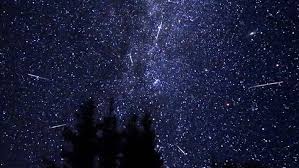Heavens to the skywatchers! For those who dared to step outside beneath the night sky, the yearly Lyrid meteor shower provided a celestial show as it peaked late on April 21st. Due to the almost full moon, the spectacle may not have been as dramatic as some showers, but the Lyrids still offered an opportunity to see light streaks from commingling comet debris.
Every year, the Lyrids peak around April 22 or 23. They are active from April 16 to April 25. The peak of the rain was forecast for this year to occur around 9:23 UTC on April 22, which translates to late evening on April 21st for most places. But it was difficult to see fainter meteors because of the large amount of light cast by the waxing gibbous moon in the night sky.
Devoted astronomers who searched out dim areas were nevertheless rewarded with views of the Lyrids even in the moonlight. When conditions are right, observers should be able to view up to 18 meteors each hour at the highest point. But there are also known outbursts from the Lyrids, with rates reaching up to 100 meteors each hour.
Generally speaking, the hours of midnight to dawn are the optimum for seeing any meteor shower. This is because we are virtually in the path of the cometary debris stream during this time due of the Earth’s rotation placing us on the leading side of the Sun.
Although it may be alluring to aim your gaze straight toward the radiant of the shower, which is the spot in the sky where the meteors seem to be coming from (seen in the constellation Lyra), experts advise against it. It is better to use your naked eye to survey a larger area of the sky because meteors are more visible from a distance away from the radiant. Selecting a spot with little to no light pollution is essential for a great meteor shower viewing experience.
Streetlights and cityscapes greatly reduce your ability to spot fainter meteors. For the best chance of seeing the display, get out of the metropolitan light and head for rural locations with clear skies. Give your eyes at least 20 to 30 minutes to acclimate to the darkness after you’ve located your position. Your eyes will get used to seeing meteors more quickly the more acclimated they are.
Being among the earliest known meteor showers, the Lyrids are unique in the annals of astronomy. Skywatchers have been in awe of this celestial occurrence for decades, with references to the shower found in ancient Chinese manuscripts dating back to 2600 BC. Comet C/1861 G1 (Thatcher) is the source of the shower; its orbital period is around 415 years. Dust and other debris are left in the comet’s wake as it moves. The debris stream causes fast-moving particles to clash with Earth’s atmosphere, burning up and producing the meteor-like flashes of light that we observe.
The meteor shower known as the Lyrids in 2024 reminded us of the wonder and beauty that exists just outside of our atmosphere, even though it may not have broken records. Even an indifferent spectator can view this breathtaking display of cosmic fireworks with a little planning and clear skies. Put April of next year on your calendars! This will be the second chance to see the comet’s leftovers and contemplate how big space is. The Lyrids will be back.


